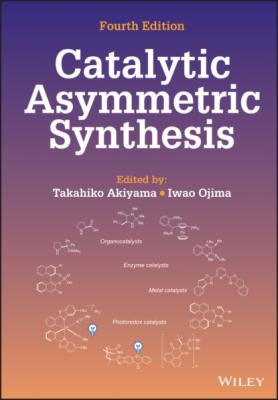Catalytic Asymmetric Synthesis. Группа авторов
Чтение книги онлайн.
Читать онлайн книгу Catalytic Asymmetric Synthesis - Группа авторов страница 51
 of alkenes (a) (
of alkenes (a) (
Source: Based on [160]
), and its application to desymmetrization of meso dienes (b) (
Source: Based on [161]).
Scheme 2.76. Hydroarylation of 1,1‐diarylethenes.
Source: Based on [158].
Yamamoto reported a bromocyclization of polyenes using 1,3‐dibromo‐5,5‐dimethylhydantoin as the electrophilic bromine source and chiral phosphoramide 14g bearing bulk 4‐(9‐antrhyl)‐2,6‐diisopropylphenyl moiety at 3,3′‐position (Scheme 2.77) [162].
Ackermann reported the first example of the activation of unactivated alkene by CPA 6b. Intramolecular hydroamination reaction took place to furnish pyrrolidine derivative with 17% ee [163]. A highly enantioselective version of the intramolecular hydroalkoxylation of unactivated alkene was developed by List using confined and strong chiral Brønsted acid [164]. Tetrahydrofuran derivatives with the stereogenic center at 2‐position and tetrahydropyrans were obtained with 84–97% ee using 11m (Scheme 2.78b). List recently achieved an intramolecular hydroarylation of unactivated alkenes with indoles catalyzed by a strong and confined chiral Brønsted acid [165]. Both alkyl and aryl‐alkenes participated in the reaction successfully to construct a quaternary stereocenter with 68–94% ee using 11n (Scheme 2.78b).
Scheme 2.77. Bromocyclization of polyenes.
Source: Based on [162].
Scheme 2.78. Intramolecular hydroalkoxylation of unactivated alkenes (a) [164], and hydroarylation of unactivated alkenes (b) [165].
2.8. SUBSTITUTION REACTIONS
Sun reported an enantioselective construction of all‐carbon quaternary stereocenters from indoles and tertiary alcohol bearing o‐hydroxyphenyl moieties using SPINOL‐derived CPA 13d (Scheme 2.79) [166]. o‐Quinone methide intermediate was generated in situ.
Scheme 2.79. Construction of all‐carbon quaternary stereocenters from indoles and tertiary alcohol.
Source: Based on [166].
Sun reported the construction of tetraarylmethanes by way of in situ generated para‐quinone methide or extended iminium intermediates catalyzed by CPA 6l to afford triaryl(2‐pyrrolyl)methane (Scheme 2.80a) and diaryl(2‐indolyl)(2‐pyrrolyl)methane (Scheme 2.80b) with 83–99% ee and 83–97% ee, respectively [167]. The presence of 2‐alkoxy moiety on the phenyl moiety was critical for the excellent enantiocontrol.
Scheme 2.80. Construction of triarylpyrrolylmethanes (a) and diarylindolylpyrrolylmethanes (b).
Source: Based on [167].
2.9. REARRANGEMENT REACTIONS
Terada reported a ring expansion reaction of 1,3‐dithianes in the presence of pyrrole using CPA 6u, forming 1,4‐dithiepane derivatives with high enantioselectivity. Indole also participated in the reaction successfully [168]. DFT calculation revealed that an unprecedented enantioselective 1,2‐sulfur rearrangement/stereospecific nucleophilic addition sequence is the concrete mechanism, which is controlled by the chiral counteranion (Scheme 2.81).
Scheme 2.81. Ring expansion reaction of 1,3‐dithianes.
Terada subsequently reported a vinylogous Wagner‐Meerwein shift through the activation of trichloroimidate as the leaving group to yield α‐vinyl cyclopentanones with high enantioselectivity using chiral phosphoramide 14c as the chiral Brønsted acid catalyst. Quaternary carbon centers were constructed with 57–95% ee (Scheme 2.82) [169].
Scheme 2.82. Vinylogous Wagner‐Meerwein shift.
Source: Based on [169].
Sun reported a House‐Meinwald rearrangement of racemic tetrasubstituted oxirane using CPA 6v or 6w to afford 2,2‐diarylcyclohexanone [170]. Chiral ketones bearing all‐carbon quaternary center at the α‐position were obtained efficiently with 86–97% ee (Scheme 2.83).
Scheme 2.83. House‐Meinwald rearrangement.
Zhu and co‐workers reported pinacol rearrangement of 1,2‐tertiary diols to furnish 2‐alkynyl‐2‐arylcyclohexanones catalyzed by N‐triflyl chiral phosphoramide 14c (Scheme 2.84a) [171]. They also reported Meinwald rearrangement of spirooxiranes to give 2,2‐diarylcyclohexanones (Scheme 2.84b).Both reactions resulted in the formation of quaternary all‐carbon stereocenters with 81–94% ee and 72–91% ee, respectively.